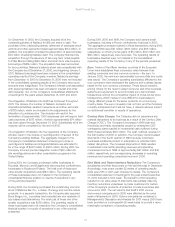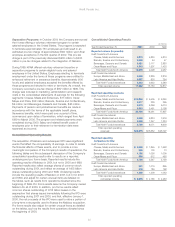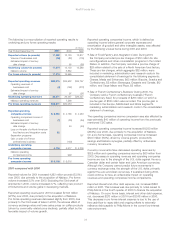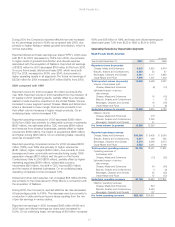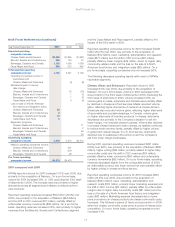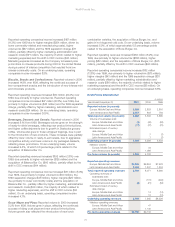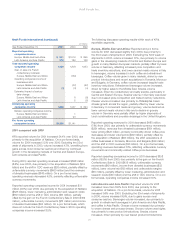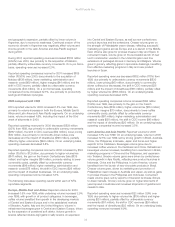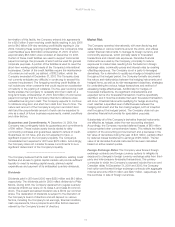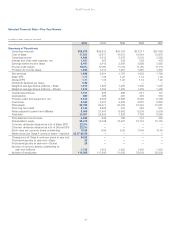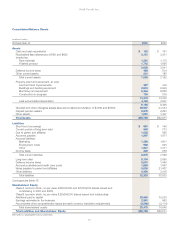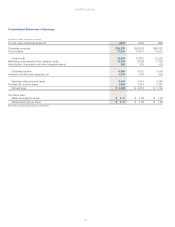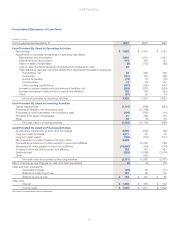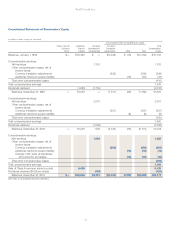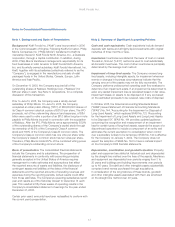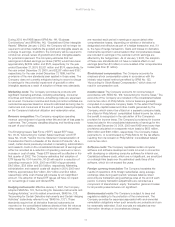Kraft 2001 Annual Report Download - page 40
Download and view the complete annual report
Please find page 40 of the 2001 Kraft annual report below. You can navigate through the pages in the report by either clicking on the pages listed below, or by using the keyword search tool below to find specific information within the annual report.
Kraft Foods Inc.
34
termination of this facility, the Company entered into agreements
for a $2.0 billion 5-year revolving credit facility expiring in July 2006
and a $4.0 billion 364-day revolving credit facility expiring in July
2002. Including these revolving credit facilities, the Company’s total
credit facilities were $6.8 billion at December 31, 2001, of which
approximately $6.5 billion were undrawn at December 31, 2001.
Certain of these credit facilities are used to support commercial
paper borrowings, the proceeds of which will be used for general
corporate purposes. A portion of the facilities is used to meet the
short-term working capital needs of the Company’s international
businesses. Certain of the credit facilities require the maintenance
of a minimum net worth, as defined, of $18.2 billion, which the
Company exceeded at December 31, 2001. The Company does
not currently anticipate any difficulty in continuing to exceed this
covenant requirement. The foregoing revolving credit facilities do
not include any other covenants that could require an acceleration
of maturity or the posting of collateral. The five-year revolving credit
facility enables the Company to reclassify short-term debt on a
long-term basis. At December 31, 2001, $2.0 billion of commercial
paper borrowings that the Company intends to refinance were
reclassified as long-term debt. The Company expects to continue
to refinance long-term and short-term debt from time to time. The
nature and amount of the Company’s long-term and short-term
debt and the proportionate amount of each can be expected to
vary as a result of future business requirements, market conditions
and other factors.
Guarantees and Commitments: At December 31, 2001, the
Company was contingently liable for guarantees and commitments
of $41 million. These include surety bonds related to dairy
commodity purchases and guarantees related to letters of credit.
Guarantees do not have, and are not expected to have, a
significant impact on the Company’s liquidity. The Company’s
consolidated rent expense for 2001 was $372 million. Accordingly,
the Company does not consider its lease commitments to be a
significant determinant of the Company’s liquidity.
The Company believes that its cash from operations, existing credit
facilities and access to global capital markets will provide sufficient
liquidity to meet its working capital needs, planned capital
expenditures and payment of its anticipated quarterly dividends.
Dividends
Dividends paid in 2001 and 2000 were $225 million and $1.0 billion,
respectively. The dividends paid in 2000 reflect dividends to Philip
Morris. During 2001, the Company declared two regular quarterly
dividends of $0.13 per share on its Class A and Class B common
stock. The present annualized dividend rate is $0.52 per common
share. The declaration of dividends is subject to the discretion of
the Company’s board of directors and will depend on various
factors, including the Company’s net earnings, financial condition,
cash requirements, future prospects and other factors deemed
relevant by the Company’s board of directors.
Market Risk
The Company operates internationally, with manufacturing and
sales facilities in various locations around the world, and utilizes
certain financial instruments to manage its foreign currency and
commodity exposures, which primarily relate to forecasted
transactions and interest rate exposures. Derivative financial
instruments are used by the Company, principally to reduce
exposures to market risks resulting from fluctuations in foreign
exchange rates, commodity prices and interest rates by creating
offsetting exposures. The Company is not a party to leveraged
derivatives. For a derivative to qualify as a hedge at inception and
throughout the hedged period, the Company formally documents
the nature and relationships between the hedging instruments and
hedged items, as well as its risk-management objectives, strategies
for undertaking the various hedge transactions and method of
assessing hedge effectiveness. Additionally, for hedges of
forecasted transactions, the significant characteristics and
expected terms of a forecasted transaction must be specifically
identified, and it must be probable that each forecasted transaction
will occur. Financial instruments qualifying for hedge accounting
must maintain a specified level of effectiveness between the
hedging instrument and the item being hedged, both at inception
and throughout the hedged period. The Company does not use
derivative financial instruments for speculative purposes.
Substantially all of the Company’s derivative financial instruments
are effective as hedges under the new accounting standard.
Accordingly, the Company recorded deferred losses of $18 million
in accumulated other comprehensive losses. This reflects the initial
adoption of the accounting pronouncement and a decrease in the
fair value of derivatives during the year of $33 million, partially offset
by deferred losses transferred to earnings of $15 million. The fair
value of all derivative financial instruments has been calculated
based on active market quotes.
Foreign Exchange Rates: The Company uses forward foreign
exchange contracts and foreign currency options to mitigate its
exposure to changes in foreign currency exchange rates from third-
party and intercompany forecasted transactions. The primary
currencies to which the Company is exposed include the euro and
Canadian dollar. At December 31, 2001 and 2000, the Company
had option and forward foreign exchange contracts with aggregate
notional amounts of $431 million and $237 million, respectively, for
the purchase or sale of foreign currencies.


